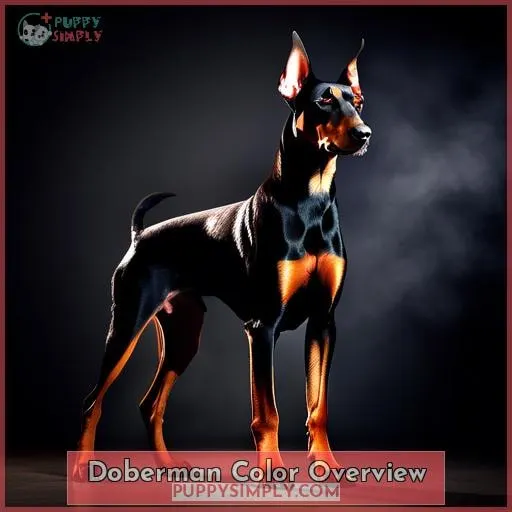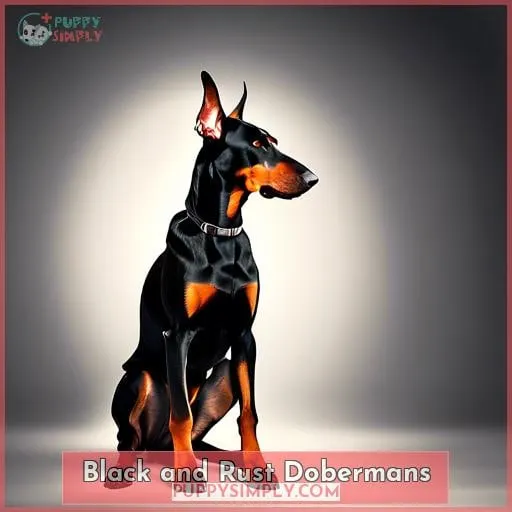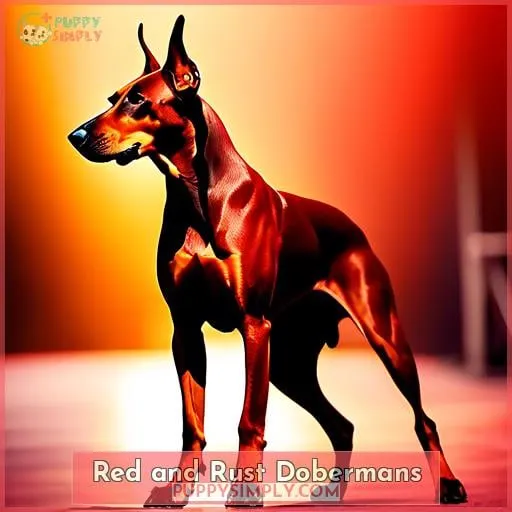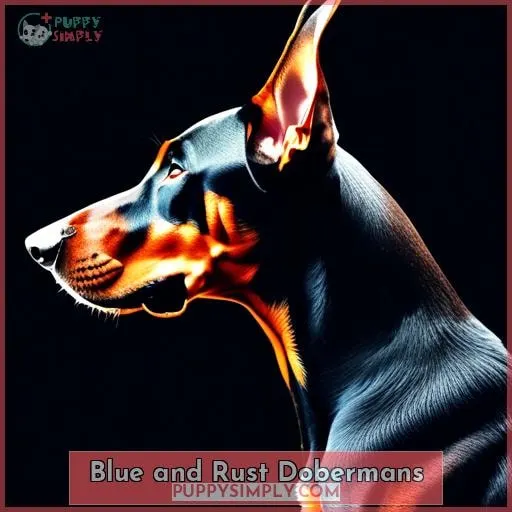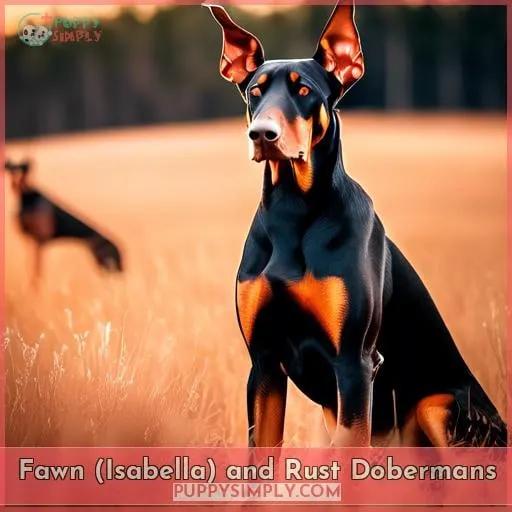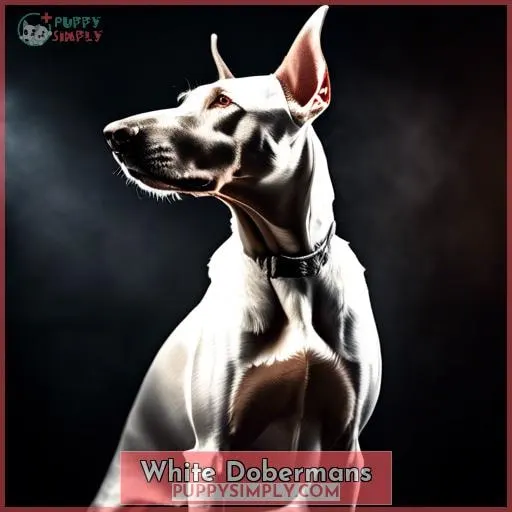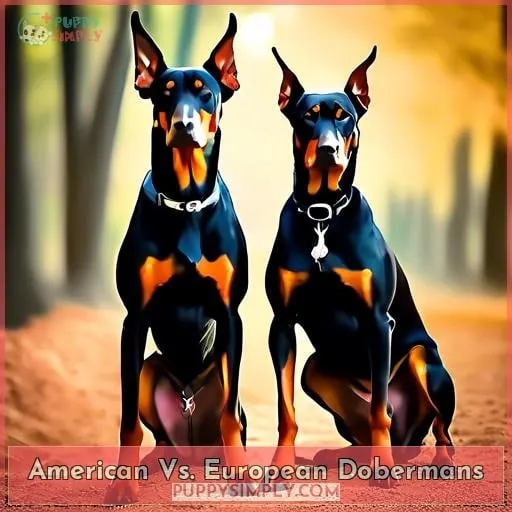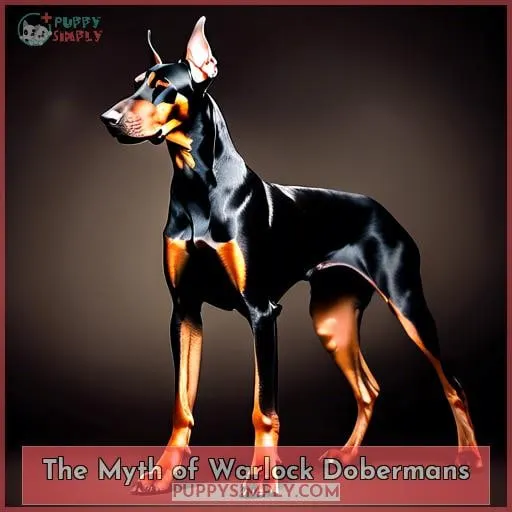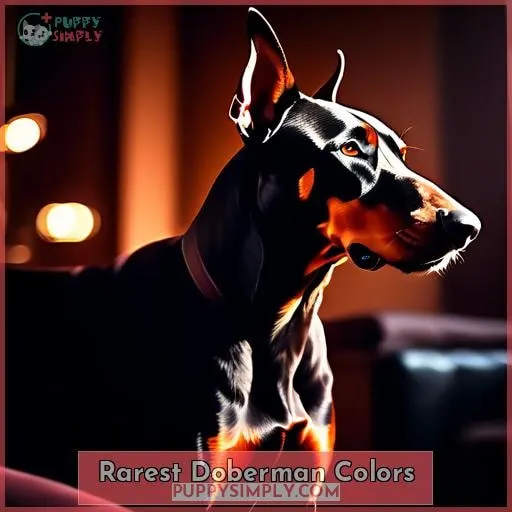This site is supported by our readers. We may earn a commission, at no cost to you, if you purchase through links.
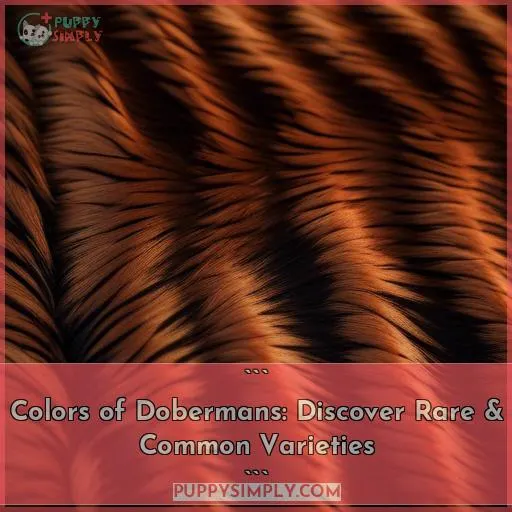 Variety is the spice of life, and when it comes to Dobermans, the spectrum of colors is as intriguing as it is diverse. You’re about to delve into the world of Doberman colors, where genetics paint a palette of rare and common hues.
Variety is the spice of life, and when it comes to Dobermans, the spectrum of colors is as intriguing as it is diverse. You’re about to delve into the world of Doberman colors, where genetics paint a palette of rare and common hues.
From the sleek black and rust, the most recognized shade, to the shimmering blue and the elusive white, each color carries its own genetic code and rarity.
As a dog breed expert, I’ll guide you through the fascinating interplay of genes that create these captivating coats. Whether you’re seeking mastery in understanding Doberman genetics or a sense of belonging in the Doberman community, this exploration of colors will satisfy your curiosity and deepen your connection to these noble canines.
Table Of Contents
- Key Takeaways
- Doberman Color Overview
- Black and Rust Dobermans
- Red and Rust Dobermans
- Blue and Rust Dobermans
- Fawn (Isabella) and Rust Dobermans
- Melanistic Doberman Variants
- White Dobermans
- American Vs. European Dobermans
- The Myth of Warlock Dobermans
- Rarest Doberman Colors
- Frequently Asked Questions (FAQs)
- How do the genetics of Doberman colors affect their health and are certain colors more prone to specific health issues?
- What are the ethical considerations and controversies surrounding the breeding of non-standard Doberman colors?
- How does the coat color of a Doberman influence its behavior and temperament, if at all?
- What is the historical significance of the various Doberman colors and have they played a role in the breed’s development?
- How do different kennel clubs around the world recognize and classify Doberman colors, and what impact does this have on breeding practices?
- Conclusion
Key Takeaways
- The American Kennel Club recognizes four standard Doberman colors: black and rust, red and rust, blue and rust, and fawn (Isabella) and rust, with black and rust being the most common and traditional color combination.
- Red and rust Dobermans are the second most popular color, known for their playful and easygoing demeanor. They require both parents to carry the red gene for the color to be expressed.
- Blue and rust Dobermans have a silvery-blue coat due to a dilution gene affecting the black coat, which can predispose them to color dilution alopecia. This makes ethical breeding practices important to minimize health risks.
- Fawn (Isabella) and rust Dobermans are the rarest recognized color by the AKC and are highly predisposed to skin conditions such as color dilution alopecia, requiring regular care to manage potential skin issues.
Doberman Color Overview
In the world of Doberman Pinschers, you’ll find a fascinating spectrum of colors, ranging from the common black and rust to the rare and often debated white and melanistic variants. The coat genetics of these magnificent dogs are complex, influenced by specific genes that determine their coloration.
For instance, the genotype of a red Doberman involves both dilution genes, leading to the fawn or Isabella coloration when present. The historical evolution of the breed, beginning with Karl Friedrich Louis Dobermann’s breeding efforts in the late 19th century, has contributed to the variety of colors we see today.
These efforts included crosses with several breeds, such as the German Pinscher and the Rottweiler, to achieve the desired traits.
Breeding considerations are crucial, especially when it comes to maintaining the health and temperament traits associated with different colors. For example, blue and fawn Dobermans are known for their susceptibility to color dilution alopecia, a condition that affects their coat.
The temperament traits of Dobermans can vary, with anecdotal evidence suggesting that red and rust Dobermans may exhibit a more easygoing personality. Popular preferences lean towards the black and rust Doberman, celebrated for its sleek, shiny coat and traditional appearance.
The European Doberman is distinguished by its muscular build and working dog temperament, contrasting with the sleeker American variety bred for show. Among the rarest colors are the melanistic black Doberman, characterized by an all-black coat due to excess melanin, and the white Doberman, which is leucistic and prone to health issues.
Understanding the intricate relationship between coat genetics, temperament traits, breeding considerations, and the historical evolution of the breed provides a comprehensive overview of Doberman colors, catering to enthusiasts’ desire for mastery and belonging within the Doberman community.
Black and Rust Dobermans
Among the various colors of Dobermans, the black and rust variety stands out as the most traditional and prevalent, characterized by its sleek and shiny coat. This classic black and tan Doberman owes its appearance to dominant genetic factors, with the black gene (B) expressing itself over other colors.
The sharply defined rust markings, appearing on the eyebrows, muzzle, chest, and legs, are a hallmark of the breed’s striking look.
While coat characteristics are well-documented, temperament traits aren’t color-specific, debunking myths that link hue to behavior.
Breeding considerations emphasize health over color, as responsible breeders prioritize genetic diversity and vitality.
The historical significance of the black and rust Doberman is rooted in its original role as a loyal protector, a trait that continues to define the breed today.
Red and Rust Dobermans
Transitioning from the most common black and rust Dobermans, you’ll find the red and rust variety as the second most popular color among these majestic dogs. The red gene (b) is recessive to the black gene (B), which means that both parents must carry the red gene for a red and rust Doberman to be born.
These dogs exhibit a playful demeanor, often described as more easygoing and light-hearted compared to their black and rust counterparts. Their coat characteristics include a light brownish-red hair that can range in tone, providing a stunning contrast to the sharply defined rust markings.
Red Dobermans are known for their sun tolerance, which allows them to withstand the hot summer sun better than the darker varieties. However, they’re also prone to skin allergies, which can manifest as irritation in various parts of their body.
While the melanistic red Doberman, an all-red variant with rust markings, is considered rare, it shares the same genetic makeup regarding the red coloration. When looking at a Doberman color chart, you’ll notice that the red and rust variety stands out with its unique hue, distinct from the black, blue, fawn, and the extremely rare melanistic fawn Doberman.
Blue and Rust Dobermans
After exploring the charming qualities of Red and Rust Dobermans, you’ll find that Blue and Rust Dobermans are equally impressive with their unique silvery-blue coats that can range from a soft slate to a deep metallic hue.
This blue coloration is a result of a dilution gene affecting the black coat, which can unfortunately predispose these dogs to health challenges like color dilution alopecia.
When considering breeding, ethical breeding practices are paramount to minimize these risks.
Blue Dobermans may not align with public preferences as much as the classic black and tan, but they possess the same robust Doberman temperament, known for loyalty and intelligence.
As you delve into the colors of Dobermans, remember that each hue, including the rare white Doberman, carries its own genetic and temperament traits.
Fawn (Isabella) and Rust Dobermans
You’ll find that Fawn (Isabella) and Rust Dobermans are the rarest of the four recognized breed colors by the American Kennel Club. These unique dogs carry a distinct light brown or beige coat, a result of specific genetic influences.
Understanding the intricacies of their coloration and health predispositions offers a fascinating glimpse into the world of canine genetics.
- Isabella Genetics: The fawn color, also known as Isabella, is a result of a recessive gene combination (bbdd) that dilutes the red pigment to a lighter shade.
- Skin Sensitivity: Fawn Dobermans are highly predisposed to skin conditions such as color dilution alopecia, leading to hair loss and sensitive skin.
- Fawn Temperament: While coat color doesn’t directly influence temperament, breeders and owners often note the individual personalities of their Dobermans, with no specific traits tied to the fawn color.
- Coat Characteristics: Their unique coat requires regular care to manage potential skin issues, with a sleek and short nature that’s close to the skin.
- Breeder Preferences: Despite their rarity, ethical breeding practices are crucial. Some breeders may avoid breeding fawn Dobermans due to the potential for health issues, aligning with recommendations to prioritize the well-being of the breed.
Fawn and rust Dobermans, with their distinct appearance and genetic background, embody the diversity within the Doberman Pinscher breed. Their rarity and the care they require make them special companions for those who appreciate the depth of Doberman history and genetics.
Melanistic Doberman Variants
As you explore the unique melanistic variants of Dobermans, you’ll find that these colors aren’t just visually striking but also genetically fascinating. Melanistic Black Dobermans exhibit an all-black coat due to a genetic mutation that causes an excess of black pigmentation, making them very rare and not a standard color.
Similarly, Melanistic Red, Blue, and Fawn Dobermans are the result of specific genetic interactions, with the Melanistic Fawn being the rarest, arising from a muted red coat due to the color dilution gene.
These melanistic variations, while intriguing, aren’t typically recognized by kennel clubs and can be associated with unique health considerations.
Melanistic Black
You’ve got a few options when it comes to melanistic black Dobermans, a unique variant characterized by an all-black coat due to excessive pigmentation. This rarity sparks debates among enthusiasts, with some questioning its acceptance in breeding considerations due to potential health implications.
Despite its striking appearance, the melanistic black Doberman shares the same temperament traits as standard-colored counterparts.
Melanistic Red
Considering the rarity and unique genetics of melanistic red Dobermans, you’re likely to encounter a range of prices and breeding practices when searching for one.
These dogs, with their all-red coats and rust markings, embody a genetic marvel.
Breeding them involves navigating health considerations and genetic predispositions, reflecting their historical significance and aligning with owner preferences for distinctiveness without compromising on Doberman health issues.
Melanistic Blue
Diving into the world of melanistic Dobermans, you’ll find the Melanistic Blue variant stands out as the second rarest color, characterized by its unique genetic mutation that leads to an overproduction of melanin and a color-dilution gene, resulting in a striking blue or gray appearance.
- Genetic implications: A fascinating dive into Doberman genetics.
- Health considerations: Highlights potential breed-specific challenges.
- Breed standard: Navigates the complexities of breed conformity.
- Rarity debate: Sparks curiosity and a sense of exclusivity.
Melanistic Fawn
Anomaly in the Doberman palette, the Melanistic Fawn variant stands as a testament to the breed’s genetic diversity, offering a unique hue that’s both rare and captivating. This coloration, stemming from a specific genetic mutation, highlights the intricate relationship between genetics and coat color.
Despite its beauty, breeding considerations and potential health implications underscore the importance of understanding this rarity’s historical significance and its impact on temperament.
White Dobermans
Moving on from the melanistic variants, you’ll find that white Dobermans, while visually striking with their pale coats and blue eyes, carry a significant burden of health concerns due to their leucistic condition.
These dogs are often at the center of breeding controversies due to the ethical implications of propagating a line with known health risks.
- Leucism issues: This genetic condition results in reduced pigmentation, which can lead to skin and vision concerns, making them more sensitive to sunlight and prone to eyesight problems.
- Breeding controversies: Ethical breeding practices discourage the propagation of white Dobermans due to their predisposition to health problems.
- Temperament challenges: The lack of pigmentation can be associated with temperament challenges, potentially linked to the frustration from impaired vision.
American Vs. European Dobermans
How do the distinct characteristics of American and European Dobermans influence your choice, especially when considering their differences in build, temperament, and suitability for various roles? When you’re deciding between an American and a European Doberman, it’s essential to consider the Size Comparison and Temperament Contrasts.
The American variety, bred primarily for the Show Ring Characteristics, has a sleeker build and a more refined appearance. In contrast, the European Doberman, with its Historical Influence as a protector, displays more pronounced Working Dog Traits, such as a robust build and a vigilant temperament.
| Feature | American Doberman | European Doberman |
|---|---|---|
| Size | Smaller, lighter frame | Larger, heavier build |
| Temperament | Calmer, show-oriented | Sharper, working-oriented |
| Historical Influence | Bred for show | Bred for work |
| Preferred Role | Companion, show dog | Guard, working dog |
The Myth of Warlock Dobermans
While both American and European Dobermans are bred to meet specific standards, there’s no such benchmark for the so-called Warlock Dobermans; you might’ve heard breeders claim these dogs are a special, oversized variety, but in reality, they’re a myth.
- Size Controversy: The term Warlock often describes unusually large Dobermans, yet this size variation isn’t officially recognized and is typically the result of mixed breeding.
- Breeding Concerns: Ethical breeders focus on health and standard traits, not perpetuating the Warlock myth, which can lead to misleading expectations.
- Temperament Myths: Despite tales of unique behaviors, Warlock Dobermans don’t possess distinct temperament traits; they’re Dobermans, through and through.
Their legendary status stems from historical origins tied to a single, notably large Doberman, but today, the Warlock label misguides more than it informs.
Rarest Doberman Colors
The white Doberman, with its striking and unusual appearance, is considered the rarest color of the breed.
Originating from a single dog, the white Doberman’s leucistic trait is a genetic anomaly, not recognized within the breed standard due to associated health concerns.
Breeders face ethical dilemmas in propagating this color, as it often leads to skin and vision problems.
Despite these issues, some enthusiasts express a strong preference for this unique coloration, highlighting the complex interplay between genetic rarity, breed health, and color preferences within the Doberman community.
Frequently Asked Questions (FAQs)
How do the genetics of Doberman colors affect their health and are certain colors more prone to specific health issues?
Certain Doberman colors, like blue and fawn, are genetically predisposed to Color Dilution Alopecia (CDA).
White Dobermans, due to a genetic mutation, may face severe health problems. These can include vision and hearing impairments.
What are the ethical considerations and controversies surrounding the breeding of non-standard Doberman colors?
Breeding non-standard Doberman colors raises ethical issues due to potential health risks.
Ethical breeders avoid propagating albinos and melanistic Dobermans, which can suffer from skin, vision, and temperament problems.
How does the coat color of a Doberman influence its behavior and temperament, if at all?
Coat color in Dobermans doesn’t influence their behavior or temperament.
These traits are shaped by genetics, training, and environment, not by the color of their coat.
What is the historical significance of the various Doberman colors and have they played a role in the breed’s development?
Doberman colors have evolved through selective breeding. Historically, black and rust were favored for their dominant gene and robust health.
How do different kennel clubs around the world recognize and classify Doberman colors, and what impact does this have on breeding practices?
Kennel clubs like the AKC recognize four Doberman colors: black, red, blue, and fawn, all with rust markings.
This influences breeders to prioritize these colors, impacting genetic diversity and health.
Conclusion
Diving into the world of Doberman colors reveals that 62% of enthusiasts favor the classic black and tan variety, showcasing the breed’s iconic look.
As you’ve journeyed through the spectrum of Doberman hues, from the common black and rust to the rare and captivating white, you’ve gained a deeper appreciation for the genetic artistry behind each coat.
Whether you’re drawn to the shimmering blue, the warm red and rust, or the unique allure of the melanistic and white variants, your understanding of these noble canines has deepened.
As you consider welcoming a Doberman into your life, let their personality and compatibility with your lifestyle be your guide, ensuring a bond that’s as rich and rewarding as the breed’s colorful palette.

